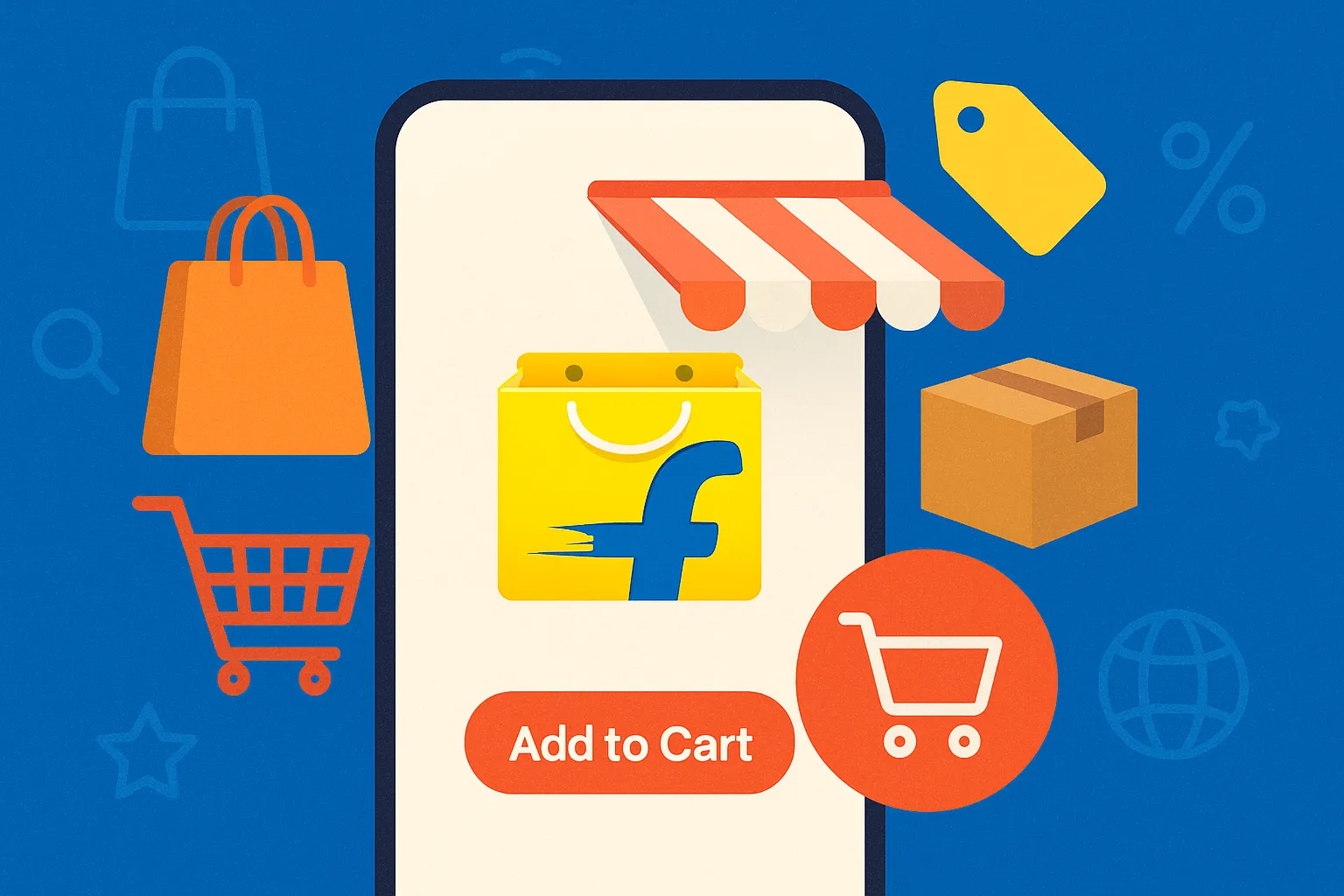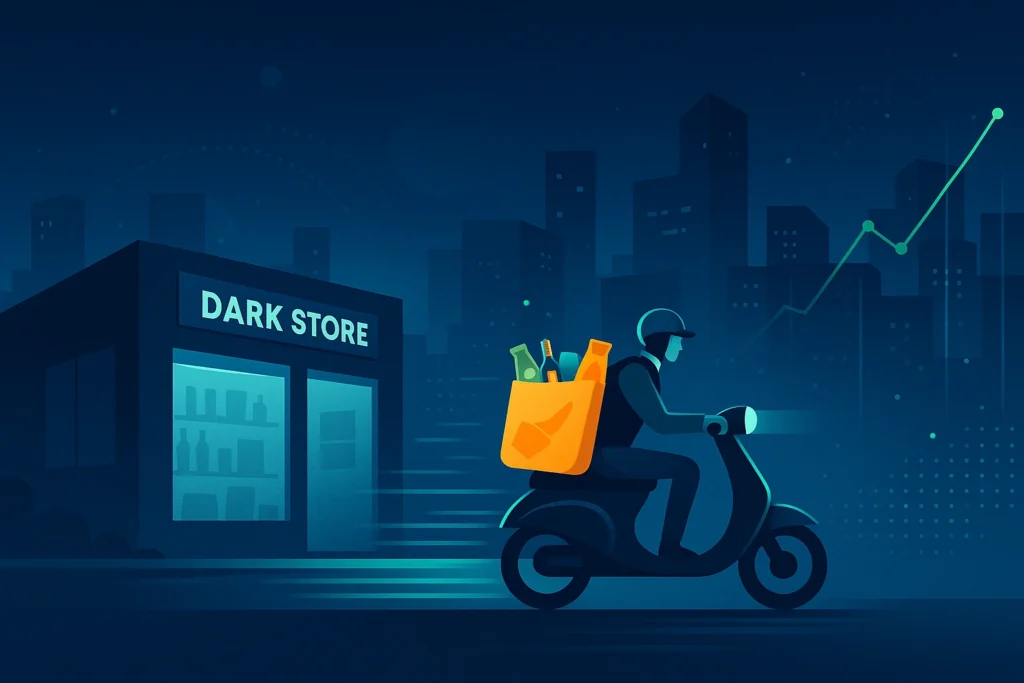Business Model of Flipkart is one of the most dominant e-commerce platforms in India, often compared with Amazon in terms of reach, inventory, and innovation. Since its inception in 2007, the company has transformed from a small online bookstore into a marketplace that caters to millions of customers across the country.
Understanding Flipkart’s business model is essential for anyone aiming to build a successful e-commerce app. Its model balances product diversity, logistics, seller enablement, and customer satisfaction — all while generating multiple revenue streams. Whether you’re an aspiring founder or a tech entrepreneur planning to launch an online marketplace, Flipkart offers a blueprint worth studying.
What is Flipkart & How It Works
What Problem Does Flipkart Solve?
Flipkart was created to solve one of India’s biggest retail challenges: limited access to quality products in smaller towns and cities. By bringing a wide range of products — electronics, fashion, home goods, groceries, and more — to consumers’ doorsteps, Flipkart revolutionized how Indians shop. It also solved major logistics and trust barriers through features like Cash on Delivery, no-questions-asked returns, and reliable delivery infrastructure.
Who Uses Flipkart?
- Consumers: From metro cities to tier 2 and tier 3 towns, Flipkart serves over 400 million users seeking competitive prices, festive discounts, and fast delivery.
- Sellers: Small businesses, brands, and manufacturers use Flipkart to reach a nationwide audience via its seller platform.
- Logistics Partners: Delivery and warehouse operators benefit from Flipkart’s expanding logistics ecosystem (eKart).
How Flipkart Operates
Business Model of Flipkart runs a multi-vendor marketplace model, where third-party sellers list and sell their products while Flipkart provides the platform, logistics, and customer service. Here’s a simple breakdown of how it works:
- Sellers list products on the Flipkart Seller Hub.
- Customers browse and purchase items via the website or app.
- Flipkart processes the payment and coordinates order fulfillment through its logistics arm (eKart).
- Products are delivered to customers with real-time tracking and post-sale support.
- Flipkart earns revenue through commission, ads, logistics fees, and more.
Read More : What is Flipkart App and How Does It Work?
Target Audience of Flipkart
Flipkart’s business model is designed to serve a wide spectrum of users across India, tapping into both urban and rural markets. Here’s a closer look at its key customer segments:
1. Price-Conscious Shoppers
- These users look for festive sales, flash deals, and discounted products.
- Mostly from tier 2 and tier 3 cities.
- Flipkart’s competitive pricing and Cash on Delivery appeal strongly to this group.
2. Tech-Savvy Urban Millennials
- Regular buyers of electronics, fashion, and lifestyle products.
- Use Flipkart for convenience, fast delivery, and EMI/pay-later options.
- Typically located in metros and tier 1 cities.
3. First-Time Online Buyers
- New to e-commerce, influenced by word-of-mouth and smartphone penetration.
- Need trust signals: easy returns, secure payments, free delivery.
4. Small and Medium Sellers
- Use Flipkart’s seller platform to reach a pan-India customer base.
- Benefit from logistics, warehousing, and advertising tools Flipkart provides.
5. Grocery and Essentials Buyers
- Flipkart Supermart targets families shopping for daily needs and groceries.
- This audience values reliability, discounts, and doorstep delivery.
Features that Support the Business Model of Flipkart
Flipkart’s revenue-generating engine is powered by a robust set of features — all carefully crafted to boost engagement, streamline operations, and drive sales. Here are the core features that directly support its business model:
1. Multi-Vendor Marketplace
- Enables thousands of third-party sellers to list their products.
- Flipkart earns commissions on each sale, without holding inventory for most items.
2. eKart Logistics Integration
- Flipkart’s in-house logistics arm ensures fast, reliable deliveries.
- Offers value-added services like next-day delivery and order tracking — enhancing user satisfaction and seller trust.
3. Flipkart Ads (Product Listing Ads)
- Sellers and brands pay to promote their listings via ads shown in search results or category pages.
- Major revenue stream through cost-per-click (CPC) and sponsored placements.
4. Flipkart Pay Later & EMI Options
- Built-in fintech features allow users to buy now and pay later.
- Drives higher order value and conversions, while Flipkart earns from partner financial institutions.
5. SuperCoins Loyalty Program
- Gamifies the shopping experience by offering reward coins.
- Encourages repeat purchases, deeper engagement, and participation in Flipkart ecosystem services (like travel, video, etc.).
6. Big Billion Days & Flash Sale Events
- Mega shopping festivals generate massive traffic and sales.
- Drives urgency, bulk orders, and brand exposure — boosting platform-wide monetization.
Read More : Best Flipkart Clone Scripts in 2025: Features & Pricing Compared
Revenue Streams of Flipkart
Flipkart’s business model is multi-layered, enabling it to earn revenue from a variety of direct and indirect channels. Below is a clear breakdown of how Flipkart makes money:
Flipkart Revenue Streams Table
| Revenue Stream | How It Works |
| Commission from Sellers | Flipkart charges sellers a percentage of each transaction (varies by category). |
| Advertising Revenue | Sellers and brands pay for visibility through product ads and sponsored listings. |
| Logistics Fees (eKart) | Sellers can opt for Flipkart’s logistics and pay for fulfillment and shipping. |
| Flipkart Plus Membership | Subscription-based loyalty program with benefits like free shipping, early access. |
| Fintech Partnerships | Flipkart earns through “Pay Later,” EMIs, and co-branded credit cards. |
| Own Product Sales | Flipkart sells in-house/private label products (e.g., MarQ, SmartBuy) directly. |
| Big Billion Day Promotions | Temporary margins from bulk brand partnerships and timed campaigns. |
Quick Summary of Each Stream
- Commission Fees: Core revenue model, similar to most e-commerce platforms.
- Ads: High-margin, scalable model that increases seller dependency on Flipkart for visibility.
- Logistics: Outsourced by many sellers, giving Flipkart control and monetization opportunity.
- Memberships: Provides predictable recurring revenue.
- Financial Services: Grows Average Order Value (AOV) while generating revenue from financial partners.
- Private Labels: Higher margins than third-party seller products.
- Events & Campaigns: Short-term spikes in profit and traffic via exclusive deals with large brands.
Read More : Revenue Model of Flipkart: How India’s E-commerce Titan Makes Money
Cost Structure of Flipkart
Running a large-scale e-commerce platform like Flipkart requires significant ongoing investment. The business model, while diverse in revenue streams, also involves high operational complexity. Here’s a breakdown of the major cost components:
1. Logistics & Fulfillment
- Flipkart’s logistics arm, eKart, demands heavy spending on:
- Warehousing
- Fleet operations
- Last-mile delivery
- Reverse logistics (returns & exchanges)
- Warehousing
2. Technology Infrastructure
- Maintaining a scalable and secure platform means continuous investment in:
- Cloud servers & data storage
- AI-based personalization engines
- Mobile app & website updates
- Cybersecurity systems
- Cloud servers & data storage
3. Marketing & Promotions
- Huge advertising budgets go into:
- Digital marketing (Google, Meta, influencer campaigns)
- Offline branding
- Big Billion Days & seasonal sale campaigns (which include steep discounts and subsidies)
- Digital marketing (Google, Meta, influencer campaigns)
4. Customer Service Operations
- Running a 24/7 multilingual customer support center requires:
- Call center staff
- Chatbot infrastructure
- Ticketing and resolution platforms
- Call center staff
5. Employee & Seller Onboarding Costs
- Flipkart employs thousands and supports a large seller ecosystem, which includes:
- Training programs
- Seller support
- Compliance & KYC management
- Training programs
6. Payment Gateway & Refund Fees
- Flipkart bears some transaction fees, especially during promotional offers or refunds, which eat into profit margins.
7. R&D and Product Development
- Costs for experimenting with new features (like voice search, AI shopping assistant, etc.) and expanding to new verticals.
2024–2025 Innovations or Updates
Flipkart has taken major strides in evolving its business model with fresh features, fintech integrations, and structural shifts over the past two years. Here’s what’s new:
1. Video Commerce to Engage Gen Z & Tier‑2/3 Cities
Flipkart has launched video commerce features under its Vibes and Swipe Screen initiative to appeal to digitally native Gen Z consumers and shoppers from smaller towns. This interactive format blends content and shopping to drive deeper engagement and higher conversions .
2. NBFC License Enables Direct Lending
In June 2025, Flipkart secured an RBI license to operate as an NBFC. This allows them to lend directly from their own books to both customers and sellers via their super.money fintech platform. This positions Flipkart to capture more profitable credit margins without relying solely on partner banks .
3. Flipkart Plus Program Upgrade
In mid‑2025, the Flipkart Plus loyalty program was enhanced, increasing SuperCoin earnings, unlocking early sale access, exclusive “treats,” and savings — reinforcing brand stickiness and recurring purchase behavior .
4. Co‑Branded Axis Bank Debit Card
Flipkart introduced a co-branded debit card with Axis Bank and Mastercard, integrating cashback, savings, and purchase protection, further anchoring users into the Flipkart ecosystem .
5. Generative AI-Powered Shopping Assistant
Flipkart rolled out Flippi, a ChatGPT‑style AI assistant, and integrated generative AI for product recommendations, dynamic pricing, and search personalization — elevating the shopping experience .
6. Focused Roll‑out of Quick Commerce
Following its launch of Flipkart Minutes (10–15 min grocery delivery), Flipkart is now strategically concentrating this service in 6–8 metro cities to optimize logistics and reduce burn .
7. Corporate Shift to India & IPO Readiness
Flipkart has relocated its holding company from Singapore to India, aligning with regulatory trends and setting the stage for a potential 2026 IPO. The recent ~$50 million employee stock buyback also indicates talent retention ahead of listing .
Key Impacts on Business Model
- Revenue Expansion: Video commerce can unlock new advertising and affiliate revenue.
- Margin Improvement: Lending via NBFC and branded financial products boost income potential.
- Customer Loyalty: Enhanced loyalty program and payment solutions lock users in.
- Efficient Spend: AI‑powered personalization drives better conversion and reduced acquisition cost.
Lean Operations: Targeted quick‑commerce deployment ensures sustainability.
Takeaways for Startup Founders
If you’re planning to build a marketplace app like Flipkart, here are key lessons and strategic moves to consider:
Consider a Multi-Stream Revenue Strategy
Flipkart doesn’t rely on just one income source. Its model mixes:
- Marketplace commission
- Ads & sponsored listings
- Logistics charges
- Premium memberships
- Fintech services
This diversification not only spreads risk but also boosts average revenue per user
Build Your Own Logistics or Partner Efficiently
In‑house logistics (like Flipkart’s eKart) give you control over delivery times, costs, and service quality. Even if you can’t build a fleet now, prioritize reliable logistics partnerships—it’s critical to scale trust and conversions.
Embed Fintech Services Early
Flipkart’s NBFC license (granted March 13, 2025) timesofindia.indiatimes.com+15reuters.com+15thesmarttips.in+15 allows it to lend directly to users and sellers. Integrating credit, ‘buy now, pay later’, or loyalty programs (like SuperCoins) can elevate order value and foster stickiness.
Lean into Content‑Led Commerce
Flipkart’s recent video commerce initiative—via “Vibes/Swipe Screen”—targets Gen Z and shoppers from smaller cities reuters.com+2newindianexpress.com+2thesmarttips.in+2stories.flipkart.com+3en.wikipedia.org+3economictimes.indiatimes.com+3. Short-form video content can enhance discovery and engagement while opening new ad revenue streams.
Test Quick Commerce Smartly
Its quick‑commerce arm (Flipkart Minutes) is now limited to top 6–8 cities to reduce burn stories.flipkart.com+2stories.flipkart.com+2stories.flipkart.com+2en.wikipedia.org+2newindianexpress.com+2economictimes.indiatimes.com+2. Piloting with laser focus in select urban centers lets startups optimize unit economics before expansion.
Why Partner with Miracuves
At Miracuves, we offer ready-made of Flipkart-style apps with end-to-end features—marketplace engine, logistics integrations, embedded fintech, AI modules, and video commerce—saving you development time and cost. Work with us to build a scalable, multi-stream revenue platform ready for fast growth.
Read more : Top 5 Mistakes Startups Make When Building a Flipkart Clone
Conclusion :
Flipkart’s business model is a masterclass in how to scale, diversify, and dominate the e-commerce space in a price-sensitive, logistics-heavy market like India. With multiple revenue streams — from commissions and ads to fintech and logistics — it has evolved far beyond a simple online store.
What makes Flipkart truly stand out is its constant innovation: video commerce, AI shopping assistants, embedded finance, and a refined loyalty ecosystem. It doesn’t just sell products — it builds an entire consumer journey powered by technology, trust, and convenience.
Thinking of Building a Flipkart-Like App?
With Miracuves, you don’t need to start from scratch. Our Flipkart app solution comes with:
- Seller management system
- Buyer-friendly mobile apps
- Secure payment & wallet integrations
- Built-in logistics & delivery modules
- Loyalty points, ratings, and rewards
- Admin dashboards with analytics
- Options to add AI & video commerce
Get to market faster, scale smarter, and monetize better — all with Miracuves as your tech partner. contact us
Let’s build your Flipkart-style marketplace today!
FAQs:
1. How does Flipkart make money without selling its own products?
Flipkart primarily earns revenue by acting as a marketplace platform. It connects third-party sellers to buyers and charges a commission on each sale. Additional revenue comes from ads, logistics services, and fintech products.
2. What is the role of eKart in Flipkart’s business model?
eKart is Flipkart’s logistics arm. It handles warehousing, shipping, and returns. Sellers can opt to use eKart and pay a logistics fee, which becomes another income stream for Flipkart. It also ensures faster and more reliable deliveries — improving customer satisfaction
3. Does Flipkart have its own brands?
Yes, Flipkart owns private label brands like MarQ (electronics) and SmartBuy (home essentials). These offer higher margins than third-party products and give Flipkart more control over pricing and quality.
4. How does Flipkart retain users?
Through the Flipkart Plus loyalty program, users earn SuperCoins, get early access to sales, and receive exclusive benefits. Flipkart also uses personalized recommendations, fast delivery, and flexible payment options to encourage repeat purchases.
5. Can startups build a similar e-commerce app with a ready-made solution?
Absolutely. Platforms like Miracuves provide ready-made Flipkart-like apps with seller dashboards, logistics modules, loyalty systems, and more — cutting down development time and cost. It’s the fastest way to launch a scalable marketplace.
Related Articles :
- Revenue Model of Etsy: How the Creative Marketplace Crafts Its Income
- Blinkit App Marketing Strategy: How It Became a Quick Commerce Leader
- Business Model of Etsy | How the Handmade Marketplace Generates Billions
- Business Model of Fancy | How This App Became a Global Marketplace
- Glovo vs Blinkit: Business Model Comparison for Startup Success








